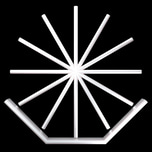Tejpal Ajji’s Direction Pieces at LAXART
Emi Kuriyama
10/24/2012

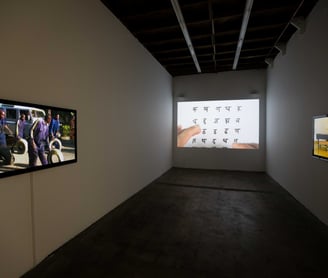
Direction Pieces, 2012. Courtesy of the artist and LAXART, Los Angeles. Photo by Michael Underwood.
Tejpal Ajji’s work takes time. In Direction Pieces, his solo exhibition at LAXART, Ajji builds a lexicon of unexpected encounters, structuring each of his performances around a single direction, word, or action. Direction Pieces is composed of three videos, one projected and two on monitors. Though each video is on a separate wall, their soundtracks overlap enabling three different locations, contexts, and moments to be experienced distinctively and also simultaneously. Ostensibly, Ajji’s work appears rather restrained––limited fields of vision, short durations, singular actions, simple scores––until the viewer’s expectations arise. Like a series of action-based koans, each video invites meditation, asking one to contemplate the structures that govern everyday exchanges and shape our understanding of cultural difference.
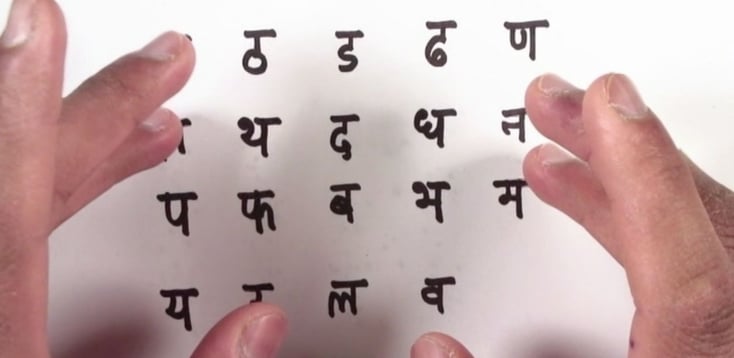

Hindi, video, 9:40 min, 2009-2011. Courtesy of the artist and LAXART, Los Angeles.
In Hindi (9:40 min, 2009-2011), a hand-written alphabet fills the frame. Fingers strike letters as Ajji voices corresponding sounds off screen.
Acknowledging the primacy of physical action, Ajji’s hands contact the hand-lettered alphabet. He repeats and isolates sounds in a chance procedure, never uttering a complete word or sentence. This performance seems to signify language, but nothing is articulated except for the peculiarities of each sign and sound. Ajji hints and points towards larger structures of cultural and ideological difference through this selected fragment, but for a moment we’re allowed to contemplate and enjoy the differences of these signs, feeling each utterance resonate through our bodies.
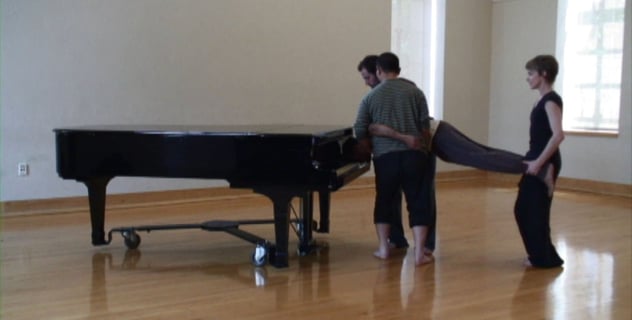

Write your text here...Tejpal Ajji, Piano, video, 1:07 min, 2010. Courtesy of the artist and LAXART, Los Angeles.
In Piano (1:07 min, 2010), three performers, acting as a tripod, drift into the frame carrying a fourth performer. Lowering and raising his body over a grand piano, they ‘play’ the instrument with his head. By playing the piano in this way, Ajji subverts any expectations one might have about this particular
action’s meaning. Certain cultural conventions inform expectations of a lone virtuosic pianist in a pristine studio; however, in Piano there are four performers who call attention to their physical coordination and subtle negotiations––indexes of the score itself. The performance emphasizes the inter-personal relationships and communication between performers, producing an atonal sound composition. Again in Ajji’s work, the primacy of physical action draws out underlying psychological and cultural assumptions in a playful attack on expectations of meaning.
Ajji consciously takes on various roles as a participant to use performance art to confound and subvert the troupes of ethnography. He denies any singular perspective of his body, shifting the proximity of the camera to the performers’ actions and relations to each other. In Hindi, Ajji’s
tapping fingers appear fragmented as his off-screen voice is bound up in action. Ajji embodies performer-as-tool, his head striking the piano keys as his body is lowered in Piano. In Auto-body shop (1:50 min, 2011), Ajji stands behind the camera. This display of performer-as-director carries echoes of the
methods of distanced observation, and subsequent representation, seen in ethnographic films. Yet, the hand-held camera moves and shakes along with the action to emphasize the subjective quality of the frame.


Tejpal Ajji, Auto-body shop, video, 1:50 min, 2011. Courtesy of the artist and LAXART, Los Angeles.
The direction of Auto-body shop revolves around an absent-object, the phantom car, as four men roll four car tires out of a garage in unison. As they reach the street, two men in white shirts hand off their tires to two men in coveralls, and the remaining four men continue until they eventually ‘park’ the absent automobile. The sun is waning; this is their last task before going home for the day. By building this performance into a key moment of the workers’ daily schedule, Ajji interrupts their reality and imagines it slightly different––creating a variation that re-opens social exchange and so-called common understanding to chance. Though retaining ties to the location’s social environment, Auto-body shop complicates a connection to the canonical tropes of ethnographic representation––a montage composition of talking heads, wide-angle contextual narrative shots, detail cut-aways, as a means to explain a situation, environment, or “culture.” Ajji’s just-under-two-minute video follows the directed action; however, the momentary handing-off of the tires from one tier of worker to another partially communicates an array of questions involving hierarchical and mimetic structures—focusing on physical gestures, clothing, moments of verbal exchange, the partially heard sentence. Ajji provides no answers. The video will loop and replay. Wheels exchange hands. They park. It starts over. Physical primacy rears its head and points towards the viewer, as Ajji reminds us that we’re in a gallery, physically positioned in an installation. We realize our proximity to Ajji’s performed roles, the real-life performers, the sites where the performances occurred. We are much farther from the men in coveralls than even the performer-as-director whose presence is indexed by a shadow; one becomes aware that the expectation of drawing total understanding from a fragmented perspective arises from an unwarranted sense of entitlement, an expectation to easily access and receive information.

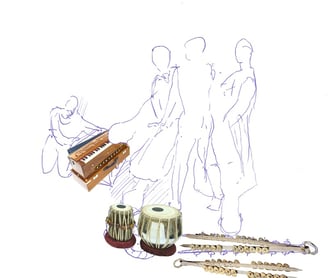
Tejpal Ajji, Harmonium, Tabla, Chimta, performance score, 2012. Courtesy of the artist and LAXART, Los Angeles.
Though Direction Pieces invites and explores a number of heady considerations, Tejpal Ajji succeeds in retaining charming simplicity and playfulness throughout his installation. The combination is an aesthetic treat. In conjunction with the closing of Direction Pieces, Ajji will be performing “Harmonium, Tabla, Chimta” with Alison D’Amato, Brennan Gerard, Ryan Kelly, and Meena Murugesan at LAXART on October 27, 7PM in his first gallery performance.
